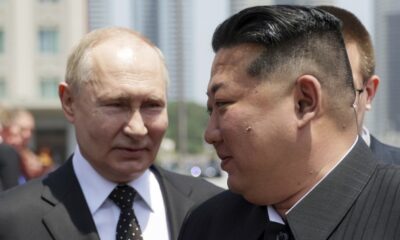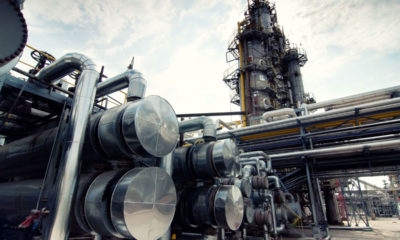The Ukraine/Russia conflict has suffered some headline fatigue of late, and more than a little complacency by the world’s financial markets, as China’s slowdown fears grabbed centre-stage. With a nod to the Rolling Stones in the title of today’s newsletter, the economic ripples of the Ukraine conflict are back on the front pages. Equity markets overnight took fright at ominous comments from Russian officials around nuclear war, but it was Russia’s announcement that Poland and Bulgaria would have their gas supplies cut off from Russia from today, unless they paid for them in Roubles, that jarred market nerves.
It seems that the weaponisation of its energy supplies by Russia has now begun, possibly driven by previously reluctant members of NATO getting on board and supplying heavy weapons to Ukraine. Germany has already stated it could painfully manage if Russia banned energy exports. Poland has said it’s gas storage is at 80%, but Bulgaria gets near 90% of its gas supplies from Russia, and its only oil refinery is owned by a Russian company. I am assuming though, that the European Union now has contingencies in place to assist immediately affected members. If this is just the start of further energy escalation by Russia, the European Union faces challenging times ahead.
That likely explains why oil prices only reversed their losses from Monday and didn’t shoot into space. Oil prices seem destined to range in a wide by choppy range. Russia concerns rightly supporting dips, while China’s slowdown fears cap gains with lots of noise in between.
Russia’s natural gas aside, markets swung back into full risk-aversion mode overnight. US yields fell, suggesting that investors were heading for shelter in that space. (bond prices move inversely to yields) The US Dollar soared, with the Euro and the risk-sentiment-correlated Australasian currencies coming in for negative attention. EUR/USD has now well and truly broken its 1985 trendline support and if Russia decides to play its gas supply card, a move below parity is on the cards.
The Nasdaq led the equity market wipe-out overnight, with its near 4.0% retreat led by Tesla, which fell by 12.20%. You could look at it two ways. Either Elon Musk sold his latest stock awards to generate the $21 billion in cash for his part of the Twitter buyout, or the street is starting to wonder how he could possibly effectively run Tesla, Starlink, Space-X and Twitter simultaneously. I do as well.
The mood will remain dark thanks to after-market Q1 results announcements by Microsoft and Alphabet. Microsoft produced an on-expectation set of results, led by the Azure Cloud division, and maintained an upbeat macroeconomic outlook. Alphabet, unfortunately, missed forecasts, thanks to a deceleration in YouTube revenues. That doesn’t really surprise me, like Meta’s platforms, advertising is now becoming intrusive in both its volume and quality, detracting from the core product. I, for one, am sick of being asked if I have pre-diabetes or having an old guy telling me I need to buy off-market cryptos for immediate capital gains.
Alphabet’s results will increase nerves about the outlook for the tech heavyweights that are announcing this week. That sector has been the last man standing in the Nasdaq index. Meta announces tonight and if my recent user experience with them is anything to go by, there is downside risk again in their results. Expect more hitting of the dislike button by US equities tonight if Meta disappoints once again. It will fall to Apple and Amazon to stop the rot.
The overnight data dump from the US was solid, if not spectacular. Durable Goods rose in March, recovering from their Ukraine slump in February. The house price indexes booked another month of gains in February, while CB Consumer Confidence remained high at 107.30 and the Richmond Fed Manufacturing Index for April was steady at 107.30. Perhaps the only blot was slowing New Home Sales, which rose by 763,000 in March versus 835,000 in February as rising mortgage rates bite. Certainly, there was nothing to suggest an impending slowdown or jarred nerves around impending Fed hikes.
Today in Asia, South Korean Consumer Confidence held steady at 103.80 and China Industrial Products YTD (YOY) rose by a much higher than expected 8.50%. that has steadied the ship in Mainland China equity markets today as the rest of Asia heads to the exit door. The big surprise has been Australian Inflation, which hit 5.10% YOY for Q1 today, well above the 4.60% rise expected.
Although the Reserve Bank of Australia is a long way from the inflation debacle that the Reserve Bank of New Zealand has created, it will ramp up the pressure on the RBA to shift its ultra-dovish stance sooner. The Australian Dollar has rallied temporarily today on that assumption. Interestingly, the RBNZ Deputy Governor is making a speech today, in Ireland on macroprudential policy implementation. At least the assembled central bankers will learn what not to do.
The rest of the day’s data calendar is strictly second-tier across the globe today. With the Fed in a pre-meeting blackout, markets will probably remain in risk aversion mode, fearful of expanding energy weaponisation by Russia, and more Covid-zero policy-related bad news from China. In all likelihood, Meta’s results this evening will define the US session in a binary outcome. Poor results will probably have a greater impact on equities in the current environment.
China is the one bright spot for Asian equities today.
The buy-the-dip rally yesterday quickly ran out of steam in New York as Tesla stock plummeted and Russia announced an impending ban on natural gas exports to Poland and Bulgaria. Although US data held steady, the miss in earnings by Alphabet has darkened the move and the overnight price action across asset classes suggested a full-on move to defensive positioning. US equities had a terrible day at the office. The S&P 500 fell by 2.80%, the Nasdaq tumbled b 3.93%, and the Dow Jones retreated by 2.38%. The S&P has fallen through its February lows, while the Nasdaq is in danger of testing its 4,100 February low. Only the Dow, with its value orientation, is holding steady, albeit a 1-year sideways range.
In Asia, the giant falls overnight in US markets have proved irresistible to bargain hunters once again. US futures have edged higher. S&P futures have added 0.45%, Nasdaq futures 0.50%, and Dow futures 0.70%. The price action looks optimistically corrective in nature.
In Asia, China is the one bright spot as markets have risen in response to a slow day for Covid-zero headlines, and better than expected Industrial Profits data. In a rerun of yesterday, the Shanghai Composite has risen by 0.40% with the narrower Shanghai 50 gaining 1.25%. The CSI 300 has rallied by 1.13%, but tellingly, Hong Kong’s Hang Seng has only edged 0.10% higher. Yesterday we saw similar gains by Mainland indexes, only for rallies to evaporate later in the day. I suspect, like yesterday, there is a little “national team” help around today. Nothing has materially changed with China’s situation and the rallies today should be treated with caution.
Elsewhere, it is a sea of red in Asia with a split once again, between the more Nasdaq-correlated North Asia heavyweights, and the more value-orientated markets of ASEAN. Japan’s Nikkei 225 has slumped by 1.45%, with South Korea’s Kospi tumbling by 1.15%, and Taipei retreating by 1.70%. Singapore is down just 0.10%, with Kuala Lumpur 0.30% lower, and Jakarta easing by 0.60%. Manila has fallen heavily by 1.75%, and Bangkok is just 0.05% lower.
Australian markets are also lower today, but not as badly as I feared after much higher than expected inflation data. Australia’s heavy resource base makes it a potential winner the more aggressive Russia becomes in the international energy and resource market. That seems to be limiting the losses in the lucky country which usually has a high US correlation. The ASX 200 is down 0.72%, while the All Ordinaries have fallen by 0.70%.
Nothing about Russia’s move to band natural gas exports to Poland and Bulgaria today can be construed as bullish for European equities. Nor can the threat of widening Russian retaliation in this space be either. As such, I expect European markets to open sharply lower today and stay that way, regardless of developments elsewhere.
US markets will be dictated by whether the FOMO gnomes of Wall Street are in bargain-hunting mode, or not. Meta’s quarterly results are likely to have the final say on whether the overnight meltdown pauses for breath or doesn’t pass go on its way directly to jail.
US Dollar soars on risk-aversion.
The US Dollar soared overnight as risk aversion swept financial markets, with the Euro having a particularly painful session as Russian risks accelerated. The dollar index smashed through 102.00 on its way to a 0.56% gain to 102.30, where it remains in Asia today. At these levels, the dollar index is potentially testing the upper boundary of a 5-year triangle. A weekly close above 103.00 resistance this week will have me pondering making a call for the 120.00 region in the months ahead. In the short-term, support lies at 101.00 followed by 99.75.
EUR/USD had a torrid session as the Russia energy risks started coming true. EUR/USD fell by 0.70% to 1.0635, before booking a tiny gain back to 1.0645 in Asia. The 1985 support line is now well and truly broken and a move back below parity in the coming months is suggested. Widening Russian energy weaponisation will hasten that outlook. In the near-term, the technical picture, potential energy sanctions on Russia, and a widening US/Europe interest rate differential, suggest EUR/USD will now test support at 1.0600 en route to 1.0300. Resistance is at 1.0760 and 1.0810.
GBP/USD fell through 1.2700 and 1.2760 overnight, on its way to a 1.30% loss to 1.2575, where it remains in Asia. Sterling is guilty by association with the Euro, with Brexit nerves around Northern Ireland, a too dovish Bank of England, and a soaring cost of living all weighing on the currency. That said, the relative strength index (RSI) is now at extreme oversold levels, meaning some sharp relief rallies are now possible. The technical picture is now signalling further losses to 1.2200 and potentially sub-1.2000 in the weeks ahead. GBP/USD would need to reclaim 1.3050 to change the bearish outlook.
Falling US yields and perhaps some haven flows into Yen itself eased the upward pressure once again on USD/JPY overnight. USD/JPY fell 0.70% to 127.25 overnight, drifting to 127.65 in Asia. USD/JPY risks remain heavily skewed higher, thanks to a hawkish Fed. Support remains at 127.00 and 126.00, with resistance at 129.50 and 130.00.
AUD/USD reclaimed most of its overnight losses today after higher than expected inflation data increased the pressure on the RBA to start tightening policy sooner. AUD/USD has rallied by 0;66% to 0.7170 today having closed below support at 0.7150 overnight. AUD/USD could spend the next few sessions consolidating between 0.7150 and 0.7250 but remains vulnerable to another US equity or Russia/China risk-aversion move. NZD/USD slumped another 0.90% to 0.6370 overnight and ominously, has not coat-tailed the AUD higher today. Short-term rallies back to 0.6700 are possible, but it remains on track to test 0.6525 and potentially, 0.6400 this week.
USD/CNH and USD/CNY traded sideways overnight and are almost unchanged at 6.5850 and 6.5540 today. The PBOC set another neutral USD/CNY fixing this morning, possibly signalling that the Yuan selloff has gone far enough for now. Additionally, stronger Industrial Profits data and a quiet Covid-zero news ticker today appear to be lending the Yuan temporary support. The plethora of China risks are now complicated by Russia’s energy militancy, and thus USD/Yuan risk remains heavily weighted to the upside, even if some short-term pullbacks are possible thanks to very overbought short-term technicals.
USD/KRW and USD/THB rose sharply overnight, but some stability in the Yuan, and lower US yields, is allowing Asia currencies to pause for breath today. Whether the relief is temporary or not is up for conjecture. A Russia-derived spike in energy prices again will certainly increase downward pressure on regional currencies. USD/MYR finally steadied and USD/INR mysteriously unwound yesterday’s palm-oil-ban gains. Like the Philippines, it appears that Bank Indonesia is back capping US Dollar gains, as is the Bank of Korea apparently.
Oil trades sideways in Asia.
Oil markets reversed their losses from Monday overnight, rising after Russia announced natural gas export bans on Poland and Bulgaria from today unless they paid in Roubles. Brent crude rose by 2.85% to $105.40, and WTI rallied by 3.10% to 101.60 a barrel. In Asia both contracts booked one per cent gains in early trading but have since given all of those back to be almost unchanged from the New York close.
The rally, spurred by rising China Industrial Profits, which alleviated slowdown fears, has evaporated as quickly as it began, suggesting that Asia markets remain much more concerned about China’s slowdown than events in eastern Europe. That complacency could come back to bite them. If Russia makes little progress in its latest offensive, the Kremlin could lash out and widen those export bans if Europe doesn’t accept the Rouble blackmail. Once Germany is included, we can assume energy prices will be heading higher once again. For now, risk aversion is capping oil’s gains.
With that in mind, I am sticking to my guns and continue to expect that Brent will remain in a choppy $100.00 to $120.00 range, with WTI in a $95.00 to $115.00 range.
Gold ponders its next move.
Gold managed to gain some risk aversion support overnight, shrugging of a much stronger US Dollar to post a modest 0.40% gain to $1904.50 an ounce. In Asia, upward momentum has quickly subsided, gold reversing 0.35% lower to $1898.50 an ounce.
The question now is, has gold’s correction lower run its course, and are we approaching levels to buy, given an escalation in geopolitical risks once again? The price action suggests not as gold rallied only modestly overnight and has quickly given back those gains today. It remains anchored at the bottom of this week’s range. Gold has support at $1891.50 and $1880.00 an ounce. Failure of $1880.00 signals a capitulation trade targeting triangle support at $1835.00, and then $1800.00 an ounce. On the topside, gold has resistance at $1915.00, $1940.00, $1980.00, and $2000.00 an ounce.


































